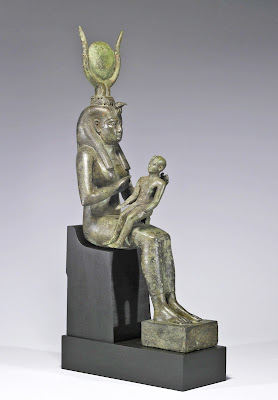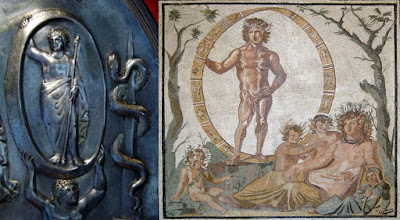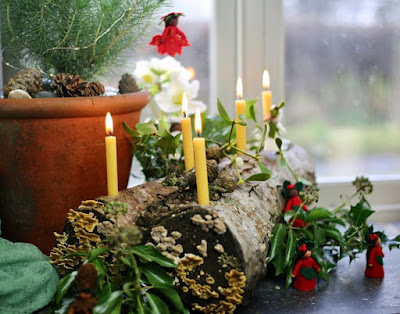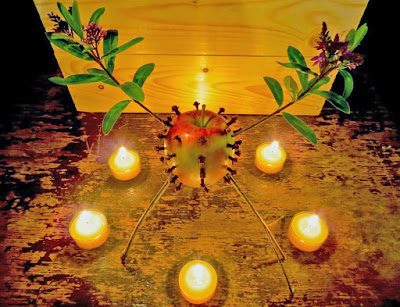hol·i·day /ˈhäləˌdā/
Other Pagan Holidays
The winter solstice is very
important in many pagan religions because it is the darkest day of the year.
Paganism is often based on the concept of duality in constant flux, dark and
light, male and female, abundance and scarcity, yin and yang if you will.
In ancient Egypt,
the god Horus was associated with the Sun and his birthday was on the winter
solstice. Plutarch writes:
Thus we shall attack the many boring people who find pleasure
in associating the activities of these gods with the seasonal changes of the
atmosphere or with the growths, sowing, and plowing of crops, and who say that
Osiris is being buried when the corn is sown and hidden in the earth, and that
he lives again and reappears when it begins to sprout. For this reason it is
said that Isis, when she was aware of her being pregnant, put on a protective
amulet on the sixth day of Phaophi, and at the winter solstice gave birth to
Harpocrates (from the Egyptian title Hor-pa-khered, or Horus the Child),
imperfect and prematurely born, amid plants that burgeoned and sprouted before
their season . . . and they are said to celebrate the days of her confinement
after the spring equinox. (On Isis and Osiris, 65 BC)
Macrobius writes:
…at the winter solstice, the sun would seem to be a little
childlike that which the Egyptians bring forth from a shrine on the appointed
day, since the day is then at its shortest and the god is accordingly shown as
a tiny infant. (Saturnalia, c. 431 AD)
Horus is the child of Isis.
They are often seen together in images of mother and child. The statuette shown
in the image here is from the 6th century BC.
A
Harvard study in 2008 concluded that Egyptian temples were constructed with
precise and purposeful alignments to the star Sirius, the winter solstice and
the cardinal points (N, S, E, W). In comparing this with the religious
practices of Egypt it is clear that much of the symbolism is the same as in
many other cultures when it comes to the winter solstice. Just before and
during the Ptolemaic period (305-30 BC), Egypt syncretized quite a lot with the
Grecco-Roman culture and vice versa. This is due largely to the influence of
priests who deified Alexander the Great.
The idea of duality is also seen
in the Germanic traditions of the Holly and Oak
Kings who are personifications of winter and summer in continuous battle.
The common belief that these
myths are based on is that the sun wanes in the winter and is almost conquered
by the dark, yet it rises again, reborn from the struggle. That is why the
Romans also called their god Sol (who became a syncretization of Apollo, Helios
and probably Mithra) by the title, “Sol Invictus” or “Unconquerable Sun.” According
to the Philocalian calendar of 354 AD they held a celebration on December 25th
called “Natalis Invicti” meaning “Birth of the Unconquerable One” who is
arguably Sol. The celebration was a prerequisite to the festival that occurred
on the 6th of January honoring Kore (known as Persephone in Greece),
the virgin maiden who gave birth to Aion at that time of year. Sound familiar?
Epiphanius, bishop of Salamis (c. 310–320 – 403AD) says that at Alexandria
(Egypt) Aion’s birth from Kore the Virgin was celebrated January 6: “On
this day and at this hour the Virgin gave birth to Aion.” The date, which
coincides with Epiphany, brought new year’s celebrations to a close, completing
the cycle of time that Aion embodies… In Ptolemaic Alexandria (305 BC-30 BC),
at the site of a dream oracle, the Hellenistic syncretic god Serapis was
identified as Aion Plutonius. The epithet Plutonius marks functional aspects
shared with Pluto, consort of Persephone and ruler of the underworld in the
Eleusinian tradition. Wikipedia
(Aion)
The reference to the Virgin
giving birth at this time of year should strike you as too coincidental. Every December
billions of people celebrate the Virgin Mary giving birth to Jesus. The
Catholics celebrate Epiphany, their revelation of “God incarnating as Christ,”
on January 6th. It’s very unlikely this is an accident. In fact, the
quote above is from a bishop in the church admitting that the pagan tradition
preceded the Christian one.
Furthermore, as early as the 4th
century BC the Eleusinian tradition taught that Persephone (aka Kore) was taken
to the underworld in the winter months, causing her goddess mother, Demeter, to
withdraw her blessing on the land so that it would get cold and nothing would
grow. Nothing but the evergreen, mistletoe and holly, of course, which are
symbols in ancient Germanic cultures of life persisting even in the dead of
winter. Let us not suppose that the Germanic peoples did not have any exchange
of tradition or influence with their Roman neighbors. If we turn again to
Tertullian, we see that Christians were putting lamps and wreaths on their
doors during certain pagan festivals.
But “let your works shine,” saith He; but now all our shops
and gates shine! You will now-a-days find more doors of heathens without lamps
and laurel-wreaths than of Christians. What does the case seem to be with
regard to that species (of ceremony) also? If it is an idol’s honor, without
doubt an idol’s honor is idolatry. If it is for a man’s sake, let us again
consider that all idolatry is for man’s sake; let us again consider that all
idolatry is a worship done to men…
“Then,” do you say, “the lamps before my doors, and the laurels on my posts are
an honor to God?” They are there of course, not because they are an honor to
God, but to him who is honored in God’s stead by ceremonial observances of that
kind, so far as is manifest, saving the religious performance, which is in
secret appertaining to demons.
Tertullian, On Idolatry, Ch. XV, c. 190 AD
Do people today not decorate their doors and windows with lights and wreaths,
even bringing evergreen trees, holly and mistletoe into their houses? “It’s
just a tree!” you might say, innocently. Is it really, or are you unwittingly
participating in paganism without even realizing it? Don’t be so quick to claim
innocence. We’ve had a mountain of information at our disposal for centuries
now, far more than enough to convict even the least discerning of us of the
true spirit behind the holiday season. If no other authority will convince you,
nor evidence staring you in the face, then take the Bible into account, which
will confirm many of these correlations you might doubt.
Trees were an essential part of
worship in Canaan too, where there existed several different variations of the
god Baal. Jeremiah lived in the 7th century BC when the Israelites
were worshiping Baal and Ashtoreth regularly. Note, though, that Baal worship
was first mentioned in Numbers 22:41, where Balaam taught Balak on the high
places of Baal how to corrupt the Israelites. This was probably sometime around
the 14th century BC. 700 years later Yahweh was prophesying through
Jeremiah about this very thing, and trees were clearly central to their idolatrous,
backsliding worship.
“Have you seen what backsliding Israel has done? She has gone up on every high mountain and under every
green tree, and there played the harlot. And I said, after she had done
all these things, ‘Return to Me.’ But she did not return… So it came to pass,
through her casual harlotry, that she
defiled the land and committed adultery with stones and trees. And yet for all
this her treacherous sister Judah has not turned
to Me with her whole heart, but in
pretense,” says Yahweh…
Only acknowledge your iniquity, that you have transgressed against Yahweh your
God,
And have scattered your charms to alien deities under every green tree,
And you have not obeyed My voice,’
says Yahweh.
Jeremiah 3:6-13
Pretense is defined as a claim
made or implied, especially one not supported by fact, or an inadequate or
insincere attempt to attain a certain condition or quality. Much of the time
people don’t even know they are being pretentious or that they are doing evil. Consider
what God prophesied to Israel through Jeremiah:
When you tell these people all these things, they will ask
you, ‘Why has Yahweh pronounced all this great
disaster against us? What is our guilt? What is the sin that we have committed
against Yahweh our God?’ Then you are to answer them: ‘It is because
your fathers have forsaken Me, declares Yahweh, and followed other gods, and
served and worshiped them. They abandoned Me and did not keep My instruction. And
you have done more evil than your fathers. See
how each of you follows the stubbornness of his evil heart instead of obeying
Me.
Jeremiah 16:10-12
The Israelites didn’t even know
they were doing anything wrong! Jeremiah goes on to elaborate on the Israelite use
of trees, describing a winter ritual celebration:
Hear the word which Yahweh speaks to you, O house of Israel.
Thus says Yahweh:
“Do not learn the way of the Gentiles;
Do not be dismayed
at the signs of heaven,
For the Gentiles
are dismayed at them.
For the customs of the peoples are futile;
For one cuts a tree from the forest,
The work of the
hands of the workman, with the ax.
They decorate it
with silver and gold;
They fasten it with
nails and hammers
So that it will not
topple.
They are upright,
like a palm tree,
And they cannot
speak;
They must be
carried,
Because they cannot
go by themselves.
Do not be afraid of
them,
For they cannot do
evil,
Nor can they do any
good.”
…But they are
altogether dull-hearted and foolish;
A wooden idol is a worthless doctrine.
Silver is beaten
into plates;
It is brought from
Tarshish,
And gold from
Uphaz,
The work of the
craftsman
And of the hands of
the metalsmith;
Blue and purple are
their clothing;
They are all the
work of skillful men.
…Everyone is
dull-hearted, without knowledge;
Every metalsmith is
put to shame by an image;
For his molded
image is falsehood,
And there is no
breath in them.
They are futile, a work of errors;
In the time of
their punishment they shall perish.
The Portion of Jacob is not like
them,
For He is the Maker
of all things,
And Israel is the
tribe of His inheritance;
Yahweh of hosts is
His name.
Jeremiah 10:1–16
This passage illustrates
several important points for us, including a description of idolatry and a
winter tradition resembling Yuletide, a Germanic pagan tradition that later
became popular in England and America. In the passage there is the worship of
nature (often in the form of pantheism, the concept that God is in everything,
so everything should be worshiped) and the works of man’s hands, which is the
very definition of idolatry. In the Old Testament there are many references to
idolatry being described as the works of man’s hands. Often times it is also
associated with silver, gold, abundance and precious possessions. Also notice
that idols usually take the shape of a man. This is because man is essentially
worshiping himself, whether he realizes it or not. The sin at the tower of
Babel in Genesis 11 was that men desired to build a tower to heaven so they
could, by the works of their own hands, be united as one people and to make a
name for themselves. As one people they grew very powerful and could accomplish
great things. What is so bad about that? The problem is they weren’t doing it
because God wanted them to. They were doing it because they wanted to. It is
believed by many scholars that they built a ziggurat of 7 tiers, and it most
likely served as an astrological temple. Although this is likely because they
said, “Come, let us build ourselves a city, and a
tower whose top is in the heavens; let us make a name for ourselves,
lest we be scattered abroad over the face of the whole earth.” It is not
conclusive they were building an astrological Ziggurat, but I think it is
implied. We do see a number of warnings against worshiping the sun moon and
stars in the Bible, the first occurrence being this:
And take heed, lest you lift your eyes to heaven, and when
you see the sun, the moon, and the stars, all the host of heaven, you feel
driven to worship them and serve them, which Yahweh your God has given to all
the peoples under the whole heaven as a heritage.
Deuteronomy 4:19
It wasn’t just the astrological
implication that was an act of defiance against God. In fact, the Bible does
elaborate on that. The problem was their will to unify and do things that were
against God’s will. In drawing from the rest of Scripture I believe it is
obvious they were building a humanist religion based on the worship of the sun,
moon and stars, ie; the creation over the
Creator. Yahweh responded by saying, “Indeed the people are one and they
all have one language, and this is what they begin to do; now nothing that they
propose to do will be withheld from them.” (Genesis 11:6) Then He scattered
them, dividing them into languages and nations. Even though He did that so long
ago, this same spirit lives in the heart of man to this day. It is why the book
of Revelation contains the imagery of Babylon the harlot riding the beast. They
are symbols of an apostate, humanist religion controlling a single world system
of government. People are still trying to build that tower. It is the spirit of
conquest, yet the conquest of God is just as different from the conquest of the
world as the Gospel of Yahshua is different from the Roman gospel.
Keeping in mind the Eleusinian
tradition of Greece mentioned earlier, recall also what the Theological
Dictionary of the New Testament said above: “Doom is feared because the
gods have withdrawn from earth.” You can see this in the tradition of the Germanic
Holly King and the Oak King as well. Even after the Germanic peoples were
Christianized trees continued to play a significant role in their folk beliefs.
That is why Prince Albert brought his Tannenbaum tradition into the palace of
England in the 1840’s. It may seem to be merely an innocently decorated tree
with no intent to worship it, but it certainly doesn’t bring any glory to God
whatsoever, regardless of how much you try to relate the symbolism of the
lights to the light of Christ or the angel at the top to Gabriel. It makes no
sense to hang biblical imagery on a pagan idol and call it Christian. It also
makes no sense to bring a tree indoors period, let alone make believe it has
some significance to your faith.
Although much of the knowledge
of Germanic ancient traditions is only speculative for lack of indigenous
documentation, we get enough glimpses into their cultures through Tacitus and
Macrobius, among others, to make solid, educated guesses at what they were
about. Many diverse resurgences of these customs throughout the centuries
assert and confirm the same beliefs and practices. One such peculiar, but
similar celebration is Calennig, a Welsh New Year’s tradition where children
decorate apples with holly or evergreen branches and cloves or dried fruit,
then go from house to house singing for goodies and presents. Often the
decorated apples were brought to other people’s houses as a good luck gift.
“Machen traces the Calennig to the Roman Saturnalia and suggests that the
custom was brought to Caerleon by the Romans” (see Calennig on Wikipedia). The Romans were present in Britain from 55BC
on and so were Germanic and Norse peoples. That’s plenty of time for their
traditions to influence and syncretize with the cultures there. I would
speculate that it was a combination of Roman and Germanic traditions. The word
Calennig derives from the Roman “kalends” which is the first day of the month
on the Roman calendar. There is a particular emphasis placed on the first
kalends of the year.
Comparatively, the
first “Christmas” trees were decorated with apples, candles and holly. The use
of holly was a part of Germanic customs, being symbolic of fertility and
protection. The word holly is a Middle English alternate spelling of the word
holy, meaning sacred, which came from the Old English holen and is cognate with
the German hulst.
Strangely enough, there was a
Medieval German custom in churches where a tree was set up, hung with apples
and wafers, symbolizing the forbidden fruit and the Eucharist, respectively. It
was called the “tree of paradise.” At that time there was question as to
whether the Tree of Life in Genesis 2-3 and the Tree of the Knowledge of Good
and Evil were the same tree. Clearly, they cannot be, for sin is death and
Christ is life. The two do not exist in one. Plus, God took the Tree of Life
away from Adam and Eve after they ate from the Tree of the Knowledge of Good
and Evil. I’m not sure how one could come to such a conclusion, but Christians
are always trying to impose some strange new idea on Scripture, so evidently,
they decided to put Christ and the commonly accepted symbol of sin on the same
tree. We might as well also note that there is no evidence suggesting the
forbidden fruit was an apple. Man, with his overly curious nature, decided to
give this fruit an identity.
If we look broadly over time, we
can see from the time of Jeremiah 10 to the Holiday Season today that pagan
winter traditions were long-standing, even more than 2700 years ago and they
have not gone anywhere. They have merely morphed and adjusted to the cultures
in which they reside. Now, they are becoming one massive, world-wide holiday.
I’m reminded of the Two Witnesses in Revelation 11:
When they finish their testimony, the beast that ascends out
of the bottomless pit will make war against them, overcome them, and kill them.
And their dead bodies will lie in the street of the great city which
spiritually is called Sodom and Egypt, where also our Lord was crucified. Then
those from the peoples, tribes, tongues, and nations will see their dead bodies
three-and-a-half days, and not allow their dead bodies to be put into graves.
And those who dwell on the earth will rejoice over them, make merry, and send
gifts to one another, because these two prophets tormented those who dwell on
the earth.
Revelation 11:7–10
(Continued…)
The winter solstice is very
important in many pagan religions because it is the darkest day of the year.
Paganism is often based on the concept of duality in constant flux, dark and
light, male and female, abundance and scarcity, yin and yang if you will.
In ancient Egypt,
the god Horus was associated with the Sun and his birthday was on the winter
solstice. Plutarch writes:
Thus we shall attack the many boring people who find pleasure
in associating the activities of these gods with the seasonal changes of the
atmosphere or with the growths, sowing, and plowing of crops, and who say that
Osiris is being buried when the corn is sown and hidden in the earth, and that
he lives again and reappears when it begins to sprout. For this reason it is
said that Isis, when she was aware of her being pregnant, put on a protective
amulet on the sixth day of Phaophi, and at the winter solstice gave birth to
Harpocrates (from the Egyptian title Hor-pa-khered, or Horus the Child),
imperfect and prematurely born, amid plants that burgeoned and sprouted before
their season . . . and they are said to celebrate the days of her confinement
after the spring equinox. (On Isis and Osiris, 65 BC)
Macrobius writes:
…at the winter solstice, the sun would seem to be a little
childlike that which the Egyptians bring forth from a shrine on the appointed
day, since the day is then at its shortest and the god is accordingly shown as
a tiny infant. (Saturnalia, c. 431 AD)
Horus is the child of Isis.
They are often seen together in images of mother and child. The statuette shown
in the image here is from the 6th century BC.
A
Harvard study in 2008 concluded that Egyptian temples were constructed with
precise and purposeful alignments to the star Sirius, the winter solstice and
the cardinal points (N, S, E, W). In comparing this with the religious
practices of Egypt it is clear that much of the symbolism is the same as in
many other cultures when it comes to the winter solstice. Just before and
during the Ptolemaic period (305-30 BC), Egypt syncretized quite a lot with the
Grecco-Roman culture and vice versa. This is due largely to the influence of
priests who deified Alexander the Great.
The idea of duality is also seen
in the Germanic traditions of the Holly and Oak
Kings who are personifications of winter and summer in continuous battle.
The common belief that these
myths are based on is that the sun wanes in the winter and is almost conquered
by the dark, yet it rises again, reborn from the struggle. That is why the
Romans also called their god Sol (who became a syncretization of Apollo, Helios
and probably Mithra) by the title, “Sol Invictus” or “Unconquerable Sun.” According
to the Philocalian calendar of 354 AD they held a celebration on December 25th
called “Natalis Invicti” meaning “Birth of the Unconquerable One” who is
arguably Sol. The celebration was a prerequisite to the festival that occurred
on the 6th of January honoring Kore (known as Persephone in Greece),
the virgin maiden who gave birth to Aion at that time of year. Sound familiar?
(Egypt) Aion’s birth from Kore the Virgin was celebrated January 6: “On
this day and at this hour the Virgin gave birth to Aion.” The date, which
coincides with Epiphany, brought new year’s celebrations to a close, completing
the cycle of time that Aion embodies… In Ptolemaic Alexandria (305 BC-30 BC),
at the site of a dream oracle, the Hellenistic syncretic god Serapis was
identified as Aion Plutonius. The epithet Plutonius marks functional aspects
shared with Pluto, consort of Persephone and ruler of the underworld in the
Eleusinian tradition. Wikipedia
(Aion)
giving birth at this time of year should strike you as too coincidental. Every December
billions of people celebrate the Virgin Mary giving birth to Jesus. The
Catholics celebrate Epiphany, their revelation of “God incarnating as Christ,”
on January 6th. It’s very unlikely this is an accident. In fact, the
quote above is from a bishop in the church admitting that the pagan tradition
preceded the Christian one.
Furthermore, as early as the 4th
century BC the Eleusinian tradition taught that Persephone (aka Kore) was taken
to the underworld in the winter months, causing her goddess mother, Demeter, to
withdraw her blessing on the land so that it would get cold and nothing would
grow. Nothing but the evergreen, mistletoe and holly, of course, which are
symbols in ancient Germanic cultures of life persisting even in the dead of
winter. Let us not suppose that the Germanic peoples did not have any exchange
of tradition or influence with their Roman neighbors. If we turn again to
Tertullian, we see that Christians were putting lamps and wreaths on their
doors during certain pagan festivals.
and gates shine! You will now-a-days find more doors of heathens without lamps
and laurel-wreaths than of Christians. What does the case seem to be with
regard to that species (of ceremony) also? If it is an idol’s honor, without
doubt an idol’s honor is idolatry. If it is for a man’s sake, let us again
consider that all idolatry is for man’s sake; let us again consider that all
idolatry is a worship done to men…
an honor to God?” They are there of course, not because they are an honor to
God, but to him who is honored in God’s stead by ceremonial observances of that
kind, so far as is manifest, saving the religious performance, which is in
secret appertaining to demons.
even bringing evergreen trees, holly and mistletoe into their houses? “It’s
just a tree!” you might say, innocently. Is it really, or are you unwittingly
participating in paganism without even realizing it? Don’t be so quick to claim
innocence. We’ve had a mountain of information at our disposal for centuries
now, far more than enough to convict even the least discerning of us of the
true spirit behind the holiday season. If no other authority will convince you,
nor evidence staring you in the face, then take the Bible into account, which
will confirm many of these correlations you might doubt.
Trees were an essential part of
worship in Canaan too, where there existed several different variations of the
god Baal. Jeremiah lived in the 7th century BC when the Israelites
were worshiping Baal and Ashtoreth regularly. Note, though, that Baal worship
was first mentioned in Numbers 22:41, where Balaam taught Balak on the high
places of Baal how to corrupt the Israelites. This was probably sometime around
the 14th century BC. 700 years later Yahweh was prophesying through
Jeremiah about this very thing, and trees were clearly central to their idolatrous,
backsliding worship.
green tree, and there played the harlot. And I said, after she had done
all these things, ‘Return to Me.’ But she did not return… So it came to pass,
through her casual harlotry, that she
defiled the land and committed adultery with stones and trees. And yet for all
this her treacherous sister Judah has not turned
to Me with her whole heart, but in
pretense,” says Yahweh…
God,
says Yahweh.
made or implied, especially one not supported by fact, or an inadequate or
insincere attempt to attain a certain condition or quality. Much of the time
people don’t even know they are being pretentious or that they are doing evil. Consider
what God prophesied to Israel through Jeremiah:
you, ‘Why has Yahweh pronounced all this great
disaster against us? What is our guilt? What is the sin that we have committed
against Yahweh our God?’ Then you are to answer them: ‘It is because
your fathers have forsaken Me, declares Yahweh, and followed other gods, and
served and worshiped them. They abandoned Me and did not keep My instruction. And
you have done more evil than your fathers. See
how each of you follows the stubbornness of his evil heart instead of obeying
Me.
they were doing anything wrong! Jeremiah goes on to elaborate on the Israelite use
of trees, describing a winter ritual celebration:
“Do not learn the way of the Gentiles;
Do not be dismayed
at the signs of heaven,
For the Gentiles
are dismayed at them.
For the customs of the peoples are futile;
For one cuts a tree from the forest,
The work of the
hands of the workman, with the ax.
They decorate it
with silver and gold;
They fasten it with
nails and hammers
So that it will not
topple.
They are upright,
like a palm tree,
And they cannot
speak;
They must be
carried,
Because they cannot
go by themselves.
Do not be afraid of
them,
For they cannot do
evil,
Nor can they do any
good.”
…But they are
altogether dull-hearted and foolish;
A wooden idol is a worthless doctrine.
Silver is beaten
into plates;
It is brought from
Tarshish,
And gold from
Uphaz,
The work of the
craftsman
And of the hands of
the metalsmith;
Blue and purple are
their clothing;
They are all the
work of skillful men.
…Everyone is
dull-hearted, without knowledge;
Every metalsmith is
put to shame by an image;
For his molded
image is falsehood,
And there is no
breath in them.
They are futile, a work of errors;
In the time of
their punishment they shall perish.
The Portion of Jacob is not like
them,
For He is the Maker
of all things,
And Israel is the
tribe of His inheritance;
Yahweh of hosts is
His name.
This passage illustrates
several important points for us, including a description of idolatry and a
winter tradition resembling Yuletide, a Germanic pagan tradition that later
became popular in England and America. In the passage there is the worship of
nature (often in the form of pantheism, the concept that God is in everything,
so everything should be worshiped) and the works of man’s hands, which is the
very definition of idolatry. In the Old Testament there are many references to
idolatry being described as the works of man’s hands. Often times it is also
associated with silver, gold, abundance and precious possessions. Also notice
that idols usually take the shape of a man. This is because man is essentially
worshiping himself, whether he realizes it or not. The sin at the tower of
Babel in Genesis 11 was that men desired to build a tower to heaven so they
could, by the works of their own hands, be united as one people and to make a
name for themselves. As one people they grew very powerful and could accomplish
great things. What is so bad about that? The problem is they weren’t doing it
because God wanted them to. They were doing it because they wanted to. It is
believed by many scholars that they built a ziggurat of 7 tiers, and it most
likely served as an astrological temple. Although this is likely because they
said, “Come, let us build ourselves a city, and a
tower whose top is in the heavens; let us make a name for ourselves,
lest we be scattered abroad over the face of the whole earth.” It is not
conclusive they were building an astrological Ziggurat, but I think it is
implied. We do see a number of warnings against worshiping the sun moon and
stars in the Bible, the first occurrence being this:
you see the sun, the moon, and the stars, all the host of heaven, you feel
driven to worship them and serve them, which Yahweh your God has given to all
the peoples under the whole heaven as a heritage.
implication that was an act of defiance against God. In fact, the Bible does
elaborate on that. The problem was their will to unify and do things that were
against God’s will. In drawing from the rest of Scripture I believe it is
obvious they were building a humanist religion based on the worship of the sun,
moon and stars, ie; the creation over the
Creator. Yahweh responded by saying, “Indeed the people are one and they
all have one language, and this is what they begin to do; now nothing that they
propose to do will be withheld from them.” (Genesis 11:6) Then He scattered
them, dividing them into languages and nations. Even though He did that so long
ago, this same spirit lives in the heart of man to this day. It is why the book
of Revelation contains the imagery of Babylon the harlot riding the beast. They
are symbols of an apostate, humanist religion controlling a single world system
of government. People are still trying to build that tower. It is the spirit of
conquest, yet the conquest of God is just as different from the conquest of the
world as the Gospel of Yahshua is different from the Roman gospel.
Keeping in mind the Eleusinian
tradition of Greece mentioned earlier, recall also what the Theological
Dictionary of the New Testament said above: “Doom is feared because the
gods have withdrawn from earth.” You can see this in the tradition of the Germanic
Holly King and the Oak King as well. Even after the Germanic peoples were
Christianized trees continued to play a significant role in their folk beliefs.
That is why Prince Albert brought his Tannenbaum tradition into the palace of
England in the 1840’s. It may seem to be merely an innocently decorated tree
with no intent to worship it, but it certainly doesn’t bring any glory to God
whatsoever, regardless of how much you try to relate the symbolism of the
lights to the light of Christ or the angel at the top to Gabriel. It makes no
sense to hang biblical imagery on a pagan idol and call it Christian. It also
makes no sense to bring a tree indoors period, let alone make believe it has
some significance to your faith.
of Germanic ancient traditions is only speculative for lack of indigenous
documentation, we get enough glimpses into their cultures through Tacitus and
Macrobius, among others, to make solid, educated guesses at what they were
about. Many diverse resurgences of these customs throughout the centuries
assert and confirm the same beliefs and practices. One such peculiar, but
similar celebration is Calennig, a Welsh New Year’s tradition where children
decorate apples with holly or evergreen branches and cloves or dried fruit,
then go from house to house singing for goodies and presents. Often the
decorated apples were brought to other people’s houses as a good luck gift.
“Machen traces the Calennig to the Roman Saturnalia and suggests that the
custom was brought to Caerleon by the Romans” (see Calennig on Wikipedia). The Romans were present in Britain from 55BC
on and so were Germanic and Norse peoples. That’s plenty of time for their
traditions to influence and syncretize with the cultures there. I would
speculate that it was a combination of Roman and Germanic traditions. The word
Calennig derives from the Roman “kalends” which is the first day of the month
on the Roman calendar. There is a particular emphasis placed on the first
kalends of the year.
Comparatively, the
first “Christmas” trees were decorated with apples, candles and holly. The use
of holly was a part of Germanic customs, being symbolic of fertility and
protection. The word holly is a Middle English alternate spelling of the word
holy, meaning sacred, which came from the Old English holen and is cognate with
the German hulst.
Strangely enough, there was a
Medieval German custom in churches where a tree was set up, hung with apples
and wafers, symbolizing the forbidden fruit and the Eucharist, respectively. It
was called the “tree of paradise.” At that time there was question as to
whether the Tree of Life in Genesis 2-3 and the Tree of the Knowledge of Good
and Evil were the same tree. Clearly, they cannot be, for sin is death and
Christ is life. The two do not exist in one. Plus, God took the Tree of Life
away from Adam and Eve after they ate from the Tree of the Knowledge of Good
and Evil. I’m not sure how one could come to such a conclusion, but Christians
are always trying to impose some strange new idea on Scripture, so evidently,
they decided to put Christ and the commonly accepted symbol of sin on the same
tree. We might as well also note that there is no evidence suggesting the
forbidden fruit was an apple. Man, with his overly curious nature, decided to
give this fruit an identity.
If we look broadly over time, we
can see from the time of Jeremiah 10 to the Holiday Season today that pagan
winter traditions were long-standing, even more than 2700 years ago and they
have not gone anywhere. They have merely morphed and adjusted to the cultures
in which they reside. Now, they are becoming one massive, world-wide holiday.
I’m reminded of the Two Witnesses in Revelation 11:
When they finish their testimony, the beast that ascends out
of the bottomless pit will make war against them, overcome them, and kill them.
And their dead bodies will lie in the street of the great city which
spiritually is called Sodom and Egypt, where also our Lord was crucified. Then
those from the peoples, tribes, tongues, and nations will see their dead bodies
three-and-a-half days, and not allow their dead bodies to be put into graves.
And those who dwell on the earth will rejoice over them, make merry, and send
gifts to one another, because these two prophets tormented those who dwell on
the earth.
Revelation 11:7–10
(Continued…)
Heart4God Website: http://www.heart4god.ws
Parables Blog: www.parablesblog.blogspot.com
Mailing Address:
Joseph Herrin
P.O. Box 804
Montezuma, GA 31063










0 Comments